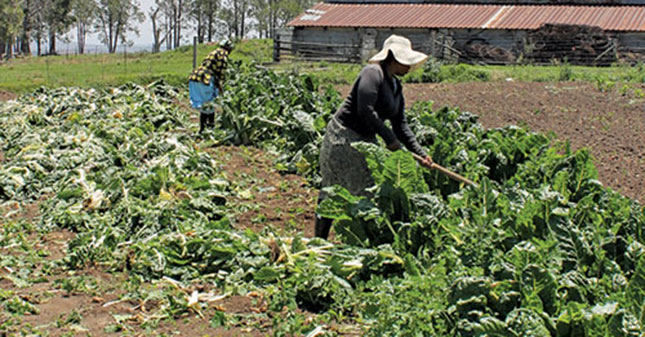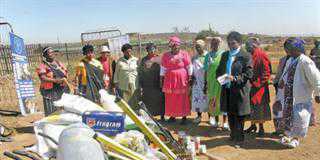By 2025, South Africa’s total water deficit is projected to be 2 044 million cubic metres a year. Dr Anthony Turton, environmental advisor and the South African Environmentalist of the Year 2010, speaks to Robyn Joubert about South Africa’s water scenario.
You’ve recently returned from a visit to Perth, Australia. What were you doing there?
I’m working as a consultant to the mining sector. I’m learning about how the Western Australian government is creating an enabling environment for sustained economic growth in the face of water-related limitations on both mining and agriculture.
The National Water Resource Strategy (NWRS) is the blueprint on which government bases its water management approach. What does the NWRS tell us about water availability?
The most recent NWRS was drafted back in 2000. It gives the best-case or “base scenario”, which shows a national deficit of 234 million cubic metres a year, and the worst-case or “high scenario”, showing a national deficit of 2 044 million cubic metres a year.
Localised deficits are projected in three geographical critical areas in terms of economic growth – KZN, the Upper Vaal and Western Cape.
My professional opinion is that the high scenario is the most likely, simply because institutional collapse has done so much harm to infrastructure, such as sewerage works, that the water stored in large dams is rapidly becoming unusable without significant improvement to water treatment.
What effect will water shortages have?
Water shortages in these areas have serious implications for SA’s future economic growth. We’re at the point where lack of water and energy is curtailing economic growth. Limpopo and North West have major mineral resources, but little of this will ever be mined simply due to lack of water.
Limpopo’s water is heavily over-allocated and massive demands will be made of it in future. By 2024, water demand in Limpopo will rise by another 146% for urban areas, 27% for rural areas, 9% for irrigation, 30% for mining and industry and 26% for power generation.
This is a 238% rise when current demand on the Limpopo River already exceeds supply by about 120%. This lack of water is becoming known as “sovereign risk”. The buzz in Perth is that SA is regarded as too high in terms of sovereign risk, so investment in mining will decline in future.
New investors won’t have the same profile and are likely to be more interested in plunder than in sustainable development. This sad reality arises from many causes, not least of which are calls by ANC Youth League leader Julius Malema to nationalise the mines.
The failed acid mine drainage response has also undermined investor confidence.
How does evaporation affect water supply?
At national level, we’re losing at least 89% of our water to evaporation. This is a concern because the era of dam-building is coming to an end.
The atmosphere is set to become thirstier as global climate change becomes more relevant. Managing evaporative losses is now becoming a national priority. If we can reduce these by a mere 1%, we’ll be able to generate “new water” on a relatively large scale.
What is “new water”?
This is one of the things I’m investigating in Western Australia. They are leaders in managed aquifer recharge using recovered sewage effluent that is banked in the ground for use 50 years later.
I’m part of a technical team investigating the viability of this as a possible solution in the Limpopo River. We would convert mine voids into engineered aquifers to provide future strategic storage of water for either agriculture or industrial use, with limited loss to evaporation.
This is called “new water”, a buzzword that is starting to grow internationally and will soon become mainstream in the SA agricultural sector.
Coal is often found in areas with high potential agricultural yield. How does air pollution from mining affect food production?
Air quality issues arise from the combustion of coal and manifests as acid rain falling across a wide area far removed from the point of combustion. Acid rain changes soil pH, mobilising aluminium trace elements, and causes pollen tube deformation in maize.
Without a properly functioning pollen tube, pollination can’t occur and the yield of our staple crop is greatly reduced.
The pollination issue hasn’t been localised to specific places and I’ve been calling for more research to determine this. It’s important for the country to know.
What effect does water pollution from mining have on food production?
Water quality issues arise from the acid mine drainage downstream of abandoned coal mining areas, of which the Olifants water management area is the best example.
It is illuminating to note that the Financial Mail reported in 2008 that the Olifants River basin, which drains an area of high energy production, has become so polluted that exports to the EU valued at R28 billion a year are now at risk.
This is a taste of things to come as our appetite for energy drives coal mining in the most productive agricultural land in South Africa.
Is desalination an option to make marginal water usable for agriculture?
Desalination will certainly be a major technology in the future. The core problems are brine disposal and energy cost. In Western Australia, massive desalination plants are in use. The Perth Water Utilities Corporation has an experimental plant where it is desalinating sewage effluent and banking the clean water underground.
As technology improves, the cost of desalination is decreasing and we’ll see many plants opening along the SA coast over the next decade.
Anything else you wish to address?
One major issue is the illegal abstraction of water by farmers along the Vaal. This is giving farming a bad name and is also forcing the early adoption of Phase II of the Lesotho Highlands Water Project.
This means we’re using future options now, because a few greedy farmers are effectively stealing a national resource.
Source: Changes in Water Availability and Demand Within South Africa’s Shared River Basins as Determinants of Regional Social-Ecological Resilience, by Ashton, PJ, Hardwick, D and Breen, CM. (Advancing Sustainability Science in South Africa, 2008).
Email Dr Anthony Turton at [email protected].













